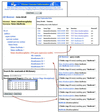The Mouse Gene Expression Database (GXD)
- PMID: 11125060
- PMCID: PMC29814
- DOI: 10.1093/nar/29.1.98
The Mouse Gene Expression Database (GXD)
Abstract
The Gene Expression Database (GXD) is a community resource of gene expression information for the laboratory mouse. By combining the different types of expression data, GXD aims to provide increasingly complete information about the expression profiles of genes in different mouse strains and mutants, thus enabling valuable insights into the molecular networks that underlie normal development and disease. GXD is integrated with the Mouse Genome Database (MGD). Extensive interconnections with sequence databases and with databases from other species, and the development and use of shared controlled vocabularies extend GXD's utility for the analysis of gene expression information. GXD is accessible through the Mouse Genome Informatics web site at http://www.informatics.jax.org/ or directly at http://www.informatics.jax.org/menus/expression_menu. shtml.
Figures

References
-
- Ringwald M., Baldock,R., Bard,J., Kaufman,M., Eppig,J.T., Richardson,J.E., Nadeau,J.H. and Davidson,D. (1994) A Database for Mouse Development. Science, 265, 2033–2034. - PubMed
-
- Ringwald M., Davis,G.L., Smith,A.G., Trepanier,L.E., Begley,D.A., Richardson,J.E. and Eppig,J.T. (1997) The Mouse Gene Expression Database GXD. Semin. Cell Dev. Biol., 8, 489–497. - PubMed
-
- Ringwald M., Eppig,J.T. and Richardson,J.E. (2000) GXD: integrated access to gene expression data for the laboratory mouse. Trends Genet., 16, 188–190. - PubMed
Publication types
MeSH terms
Grants and funding
LinkOut - more resources
Full Text Sources

